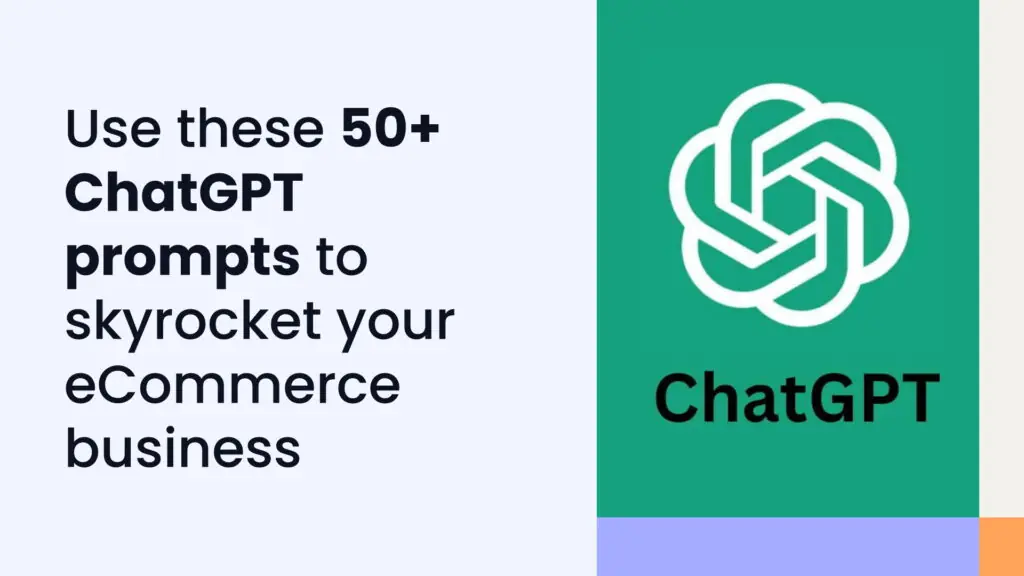While many people look at ChatGPT and its ilk as the death of creativity, eCommerce sellers and entrepreneurs already know that it is one of the finest tools for content creation en masse. Even if you’re the type of person who likes to do it all by yourself, like most eCommerce sellers and entrepreneurs, you understand you’d benefit greatly from the assistance of a quick, trusty digital tool by your side.
Content creation for eCommerce is something that can take hours, if not days, of hard thinking. By integrating OpenAI’s capabilities, you’ll be able to streamline the production process of content for your business in no time at all, and with minimum expenses (and effort) spent.
Following our article on 100 ChatGPT questions that are also designed to help eCommerce sellers, we set out to create a more detailed list of prompts that are aimed at generating precise responses, resulting in maximum convenience and outstanding results for eCommerce sellers.
In order for these prompts to work well, it is advisable to provide as much information about your business upfront as possible. The more detailed and informative you are, the more personalized the results will be, leading to little to no changes in the end result.
Here are over 50 prompts for eCommerce sellers to save and use daily:
Prompts for product descriptions
Writing product descriptions can be a tricky ordeal. Using the right keywords is an important part of the process, and so is SEO (search engine optimization) – as high search engine ranking is a great way to boost your visibility. These following prompts will help you achieve accurate responses that’ll either be the exact thing you use on your website or selling platform, or a great catalyst into the finished product –
1. “Write a compelling, SEO-optimized product description for our business’s [product name] that highlights its key features, benefits, and unique selling points. The description should be no longer than [maximal number] words, written in a [tone of choice] tone, and include relevant keywords like [specific keywords]. Make sure to address the target audience’s pain points and how this product solves them.”
2. “Craft a detailed product description for our business’s [product name] that emphasizes its benefits for [specific audience]. The description should include a short introduction, bullet points for key features, and a closing sentence that invites the customer to take action. The tone should be [tone of choice], and the description should be between [number] to [number] words.”
3. “Write an SEO-optimized product description for our business’s [product name] that tells a story about the product’s creation or inspiration. Include how the product solves a common problem for the target audience. The tone should be [tone of choice], and the description should be under [number] words.”
4. “Create a comparison-style product description that contrasts our business’s [product name] with a competing product. Highlight the advantages of our product, including features, pricing, and customer reviews. The tone should be [tone of choice], and the description should be no longer than [number] words.”
Subscribe to the eCommerce newsletter for
top industry insights
5. “Develop a product description for our business’s [product name] aimed at environmentally-conscious consumers. Focus on the product’s sustainability, eco-friendly materials, and any certifications it has received. The tone should be [tone of choice], and the description should be under [number] words.”
6. “Compose a product description for our business’s [product name] that emphasizes its luxury or premium qualities. Include sensory language that evokes the feel, look, and experience of the product. The tone should be [tone of choice], and the description should be concise, no more than [number] words.”
7. “Write a product description for our business’s [product name] that is tailored to [a specific demographic, such as millennials or parents]. Focus on the benefits that are most relevant to this audience and include any features that set the product apart. The tone should be [tone of choice], and the description should be no longer than [number] words.”
8. “Create an SEO-friendly product description for our business’s [product name] that includes a brief product history or origin story. The description should weave in keywords naturally and maintain a [tone of choice] tone. Keep the length to [number] words.”
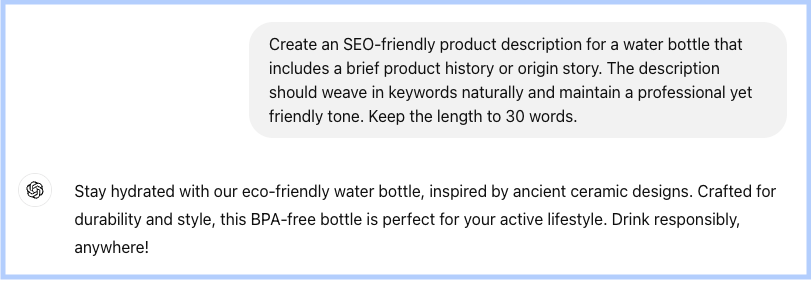
Prompts for email marketing
Email marketing is an amazing tool to build lasting relationships with your customers – essentially, it’s one of the most powerful tools eCommerce sellers have to communicate with their clients. Using email marketing, you can directly reach your paying customers, drive sales, and establish strong relationships.
Good email marketing campaigns naturally rely on good copy. Well-crafted email copy not only captures the reader’s attention but also clearly communicates the value of the product or service, encourages action, and fosters trust. Good copy is the difference between an opened email and one that’s ignored.
9. “Create an engaging email marketing campaign for a new product launch – [new product details]. The email should include a catchy subject line, a personalized greeting, and persuasive body content that explains the product’s features and benefits. Include a clear and compelling call to action (CTA). The tone should be [tone of choice], and the email should be optimized for mobile devices.”
10. “Write an email sequence for a cart abandonment campaign. The sequence should include three emails: a reminder about the items left in the cart, an offer of a discount or incentive to complete the purchase, and a final email that creates urgency. The tone should be [tone of choice], and each email should be concise and action-driven.”
11. “Create a welcome email for new subscribers to our eCommerce store’s newsletter – [name of eCommerce store]. The email should introduce the brand, highlight a few popular products, and offer a special discount or freebie as a thank you for signing up. The tone should be [tone of choice], and the email should be optimized for mobile viewing.”
12. “Develop an email marketing campaign for a seasonal promotion (such as a summer sale). The campaign should include a teaser email, a launch email, and a last-chance email, each with a compelling subject line and clear call to action. The tone should be [tone of choice], and the emails should be visually appealing.”
13. “Write a re-engagement email for inactive customers who haven’t made a purchase in the last [number of months]. The email should include a personalized greeting, a special offer to encourage them to return, and a reminder of what makes our store unique in our niche – [name of your eCommerce store’s niche]. The tone should be [tone of choice], and the email should be friendly and inviting.”
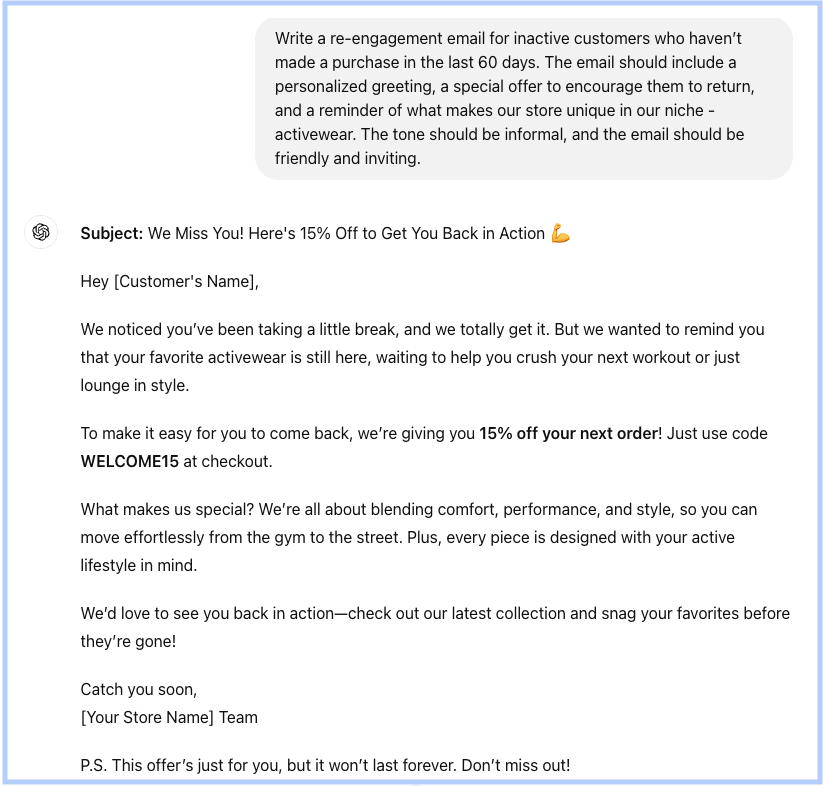
14. “Develop an email to announce a new loyalty program for our eCommerce store – [name of eCommerce store]. The email should explain the benefits of joining, how the program works, and include a clear CTA to sign up. The tone should be [tone of choice], and the email should be mobile-friendly.”
15. “Write an email promoting a flash sale on [specific product or category]. The email should create urgency, highlight the discount or offer, and include a strong call to action. The tone should be [tone of choice], and the email should be visually appealing with attention-grabbing headlines.”
16. “Create a follow-up email to a webinar or online event that encourages attendees to take the next step, whether it’s purchasing a product, signing up for a service, or scheduling a consultation. The tone should be [tone of choice], and the email should include a summary of key points from the event and a clear CTA.”
Prompts for blog writing
We personally understand that eCommerce sellers know what they’re doing in many departments of operating their businesses, but blog writing is not always their strongest suit. Well, with these prompts, it becomes a breeze:
17. “Generate a detailed outline for a blog post about [topic]. The post should target [your typical clients] and be optimized for SEO with keywords like [specific keywords]. Include an engaging introduction that hooks the reader, 3-5 main sections with subheadings, and a conclusion that encourages reader engagement or includes a CTA. The tone should be [tone of choice], and the post should be structured for easy readability.”
18. “Write a blog post outline on the topic ‘[topic].’ The post should include an engaging introduction, 3-4 main sections with subheadings, and a conclusion that encourages reader interaction or further exploration of our products. The tone should be [tone of choice], and the post should be optimized for SEO with keywords like [specific keywords]. It should be no more than [desired amount of] words.”
19. “Create a listicle blog post titled ‘[number] Ways to Use Our [specific product / service of your business].’ Each point should be concise, actionable, and supported by examples or data where possible. The tone should be [tone of choice], and the post should be structured for easy skimming.”
20. “Write a how-to guide blog post that explains the process of [a task related to your eCommerce business, e.g. ‘how to use our app,’ ‘how to return a product,’ etc.]. The guide should be broken down into clear, step-by-step instructions with tips and best practices. The tone should be [tone of choice], and the post should be optimized for beginners / first time clients.”
21. “Generate a blog post that explores the latest trends in [your business’s specific industry]. Include examples of how these trends are influencing the market and offer advice on how clients can behave accordingly. The tone should be [tone of choice], and the post should include relevant keywords for SEO.”
22. “Generate a blog post that offers a deep dive into a case study of a successful client that used our [product / service]. Include data, quotes, and lessons that other similar businesses can learn from. The tone should be [tone of choice], and the post should be optimized for SEO with relevant keywords – [list of necessary keywords].”
23. “Create a roundup blog post of the top [number] tools and resources for our clients in [current year]. Each tool / resource should include a brief description, pros and cons, and why it’s valuable for sellers. At the end of the article, include a short promotion for our solution, including major pain points our service can solve for them – [expand on pain points]. The tone should be [tone of choice], and the post should be structured for easy reading and skimming.”
24. “Generate a list of [number] blog posts that could resonate with [your business’s specific target audience]. Each blog post idea should include a catchy title, a brief description of the content, and the primary SEO keywords to focus on. The posts should be designed to drive engagement, educate the audience, and ultimately lead to conversions. The tone should be [tone of choice], and the topics should align with the overall content strategy and goals of [your eCommerce brand].”
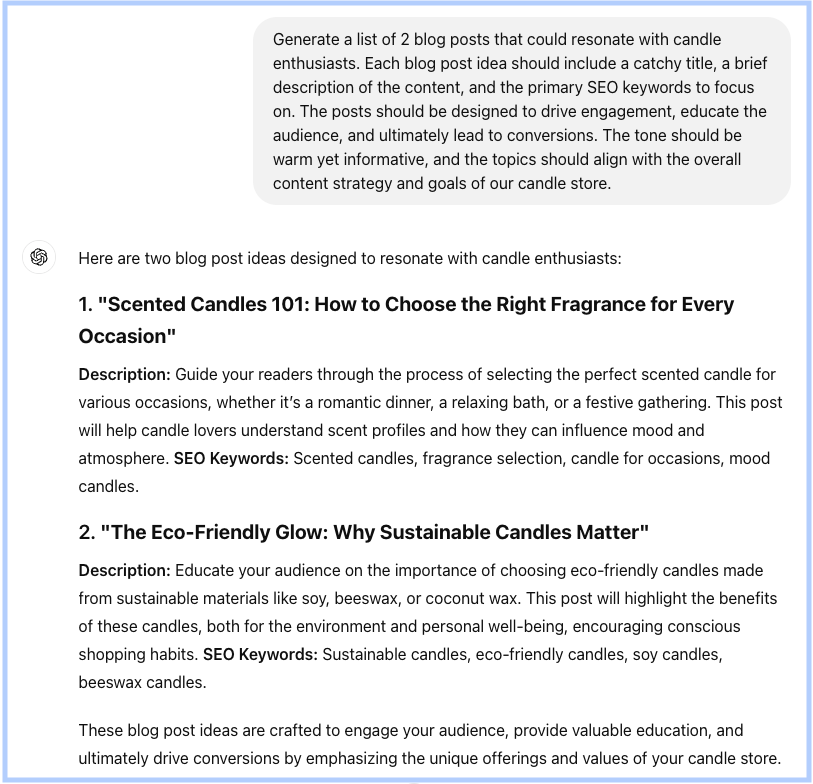
Might also interest you:
Popular content
- 14 strategies to improve your eCommerce business’s financial health
- 50+ ChatGPT prompts to elevate your eCommerce business
- A guide to pricing your product on Amazon
- 5 marketing metrics all eCommerce businesses should track
- All about Amazon PPC
- 100 questions for eCommerce sellers to ask ChatGPT
- Tips for using ChatGPT to further your eCommerce store
- The ultimate guide to AI in eCommerce
Prompts for sales copy
Sales copy includes anything that has to do with sales and promotions – persuasive landing pages, promotional banners, and sales pitches. It’s yet another important aspect of content creation for your business that can be hard to crack, which is exactly why we created these prompts for you:
25. “Write persuasive sales copy for a landing page promoting [your business’s product / service]. The copy should be SEO-optimized, emphasize the product’s unique selling points which are [expand on selling points], and include a strong CTA. The tone should be [tone of choice], and the copy should be no longer than [maximal number] words. Incorporate testimonials or social proof to build credibility.”
26. “Write a short, persuasive tagline for our business’s new [product / service] launch that captures the product’s essence and appeals to its target audience – [room for expansion on said product / service]. The tagline should be no more than [number] words and should be memorable and impactful.”

27. “Create a promotional banner copy for a limited-time offer on our business’s [specific product or category]. The copy should highlight the discount percentage, the urgency of the sale, and a clear CTA. The tone should be [tone of choice], and the copy should be concise and visually engaging.”
28. “Develop a persuasive headline and subheadline for a landing page focused on converting visitors into buyers for [specific product or service]. The headline should grab attention, and the subheadline should provide a compelling reason to explore further. The tone should be [tone of choice], and the text should be optimized for conversions.”
29. “Write a short sales pitch for our business’s [product / service] that could be used in a cold email or social media ad. The pitch should include a hook, a brief description of the product’s benefits, and a clear CTA. The tone should be [tone of choice], and the pitch should be no more than [number] words.”
30. “Develop a headline and subheadline for a promotional flyer or brochure that will be distributed at a trade show. The copy should grab attention and clearly convey the benefits of our [product / service]. The tone should be [tone of choice], and the copy should be concise and impactful.”
31. “Write a brief sales pitch for our business’s [product / service] that could be used in a video script or podcast ad. The pitch should introduce the product, highlight key benefits, and end with a compelling CTA. The tone should be [tone of choice], and the copy should be under [number] words.”
32. “Create an attention-grabbing pop-up message for our website that offers a discount or freebie in exchange for signing up for our newsletter. The message should include a clear value proposition and a simple CTA. The tone should be [tone of choice], and the message should be short and to the point.”
Prompts for content planning
Creating content is not just about coming up with the perfect sentence or catchy phrase, it’s about planning ahead and creating a full-on yearly plan (or gantt) to stay ahead of the competition. These next prompts will help you with content calendars, campaign ideas, and building long-term strategies.
33. “Develop a content calendar for the next quarter focused on promoting our business’s [specific product or theme]. Include blog post topics, email campaigns, social media posts, and any seasonal promotions. The plan should include suggested posting dates, target audience, and key objectives for each piece of content. Consider SEO strategies and keywords for each content type.”
34. “Create a content strategy for launching a new product line in [specific month or season]. The strategy should include blog posts, social media content, email campaigns, and any promotional events or partnerships. Each piece of content should have a specific objective and target audience according to this instruction – [expand on objective and target audience], with an overall goal of building anticipation and driving sales.”
35. “Develop a 12-month content calendar for our eCommerce brand that sells [specific type of products]. The calendar should include key marketing campaigns, blog post ideas, social media content themes, and important dates like holidays and industry events. Each entry should include a brief description of the content and its intended purpose.”
36. “Plan a series of educational content pieces (blog posts, videos, webinars) that aim to establish our brand as an authority in [specific niche]. The content should address common pain points, offer solutions, and include CTAs that encourage further engagement with your brand. The tone should be [tone of choice], and the content should be spread out over a quarter.”
37. “Generate content ideas for a month-long social media campaign promoting our business’s [specific product or event]. The campaign should include a mix of posts, stories, and ads that tell a cohesive story, build excitement, and encourage user-generated content. Each idea should include suggested visuals, hashtags, and posting schedule.”
38. “Plan a content series focused on educating our audience about [specific topic]. The series should include blog posts, videos, and infographics that can be shared across our website and social media channels. Each piece of content should be designed to build upon the previous one, culminating in a final, comprehensive guide or ebook.”
39. “Develop a content plan for a month-long customer appreciation campaign. The plan should include a mix of blog posts, emails, social media posts, and special offers that highlight our customers’ stories, successes, and feedback. The tone should be [tone of choice], and the content should aim to strengthen customer loyalty.”
40. “Create a content roadmap for launching a new feature or service on our business’s website. The roadmap should include teaser content leading up to the launch, educational posts explaining the new feature, and promotional materials to drive adoption. Each content piece should have a clear goal and target audience.”
Prompts for social media content
Every successful eCommerce seller knows that there’s no point in selling online unless you have a strong social media presence. These days, a lot of potential buyers spend most of their time on social media, and research shows that nearly half of all social media users have purchased something after seeing an ad, a number that increases for millennials (53%) and women (56%).
This valuable information clearly explains why social media content is one of the most important categories on this list.
41. “Create a series of five Instagram posts to promote our business’s [product / event]. Each post should include an engaging caption, relevant hashtags, and a CTA. The tone should be [tone of choice], and the content should be optimized for Instagram’s algorithm, focusing on visual appeal and audience engagement. Include suggestions for accompanying visuals or photos.”
42. “Create an SEO-optimized Facebook ad copy for promoting a limited-time offer on our business’s [product / service]. The copy should be attention-grabbing, clearly communicate the offer, and include a strong CTA. The tone should be [tone of choice], and the ad should be optimized for both desktop and mobile views.”
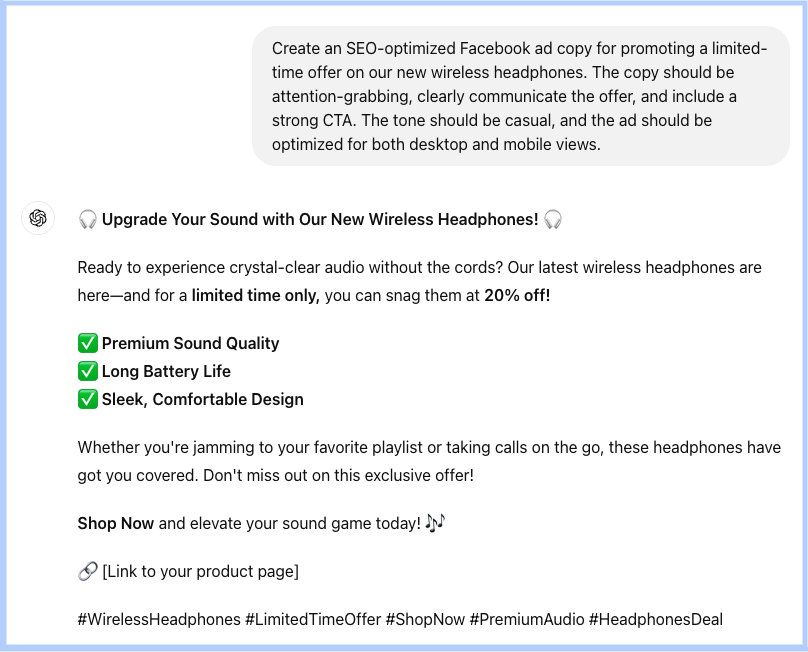
43. “Write a LinkedIn post that shares a success story about how our product or service helped a customer achieve [specific result] – [expand on success story]. The post should include a brief case study, relevant hashtags, and a link to a detailed blog post or landing page – [provide link]. The tone should be [tone of choice], and the post should be professional yet relatable.”
44. “Develop an X thread that discusses the benefits of using our business’s [product / service] for [specific audience]. Each message should build on the previous one, include relevant hashtags, and encourage reposts or replies. The tone should be [tone of choice], and the thread should aim to educate and engage followers.”
45. “Create an Instagram story series that showcases the behind-the-scenes process of creating our business’s product or preparing for a big event – [provide additional information]. Each story should include engaging visuals, text overlays, and interactive elements like polls or questions. The tone should be [tone of choice], and the content should be optimized for Instagram’s format.”
46. “Write a series of three LinkedIn posts designed to showcase our business’s thought leadership in [specific industry / niche]. Each post should focus on a different aspect of your expertise, include relevant data or insights, and encourage engagement through comments or shares. The tone should be [tone of choice], and the posts should be tailored for a professional audience.”
47. “Develop a Pinterest pin description for a product that appeals to DIY enthusiasts. The description should highlight how our business’s product can be used in creative projects, include relevant keywords, and end with a CTA to visit our website – [provide link]. The tone should be [tone of choice], and the description should be optimized for search.”
48. “Create a TikTok script for a short video that promotes our business’s new product launch – [expand on said product]. The script should be engaging, highlight the product’s key features, and include a clear CTA. The tone should be [tone of choice], and the video should be designed to capture attention within the first few seconds.”
Prompts for customer communication
Creating a relationship with your customers depends on many things, but it starts with your vision – how do you want to interact with your clients? What type of language would you like your staff to use? Which kind of connection do you wish to foster with your target audience?
All of these questions should lead you to developing a customer communication strategy that fits your brand and your values; use these prompts to help you get there:
49. “Write a response template for common customer inquiries about our business’s [specific issues]. The response should be polite, empathetic, and solution-oriented, providing clear instructions or next steps. The tone should be [tone of choice], and the template should be adaptable for various customer service scenarios.”
50. “Write a follow-up email to our customer who recently made a purchase. The email should thank them for their order, provide any relevant tracking information, and invite them to leave a review or share their experience on social media. The tone should be [tone of choice], and the email should include a link to customer support in case of any issues.”
51. “Develop a script for a customer service chat interaction where our customer is inquiring about the status of their order. The script should be polite, informative, and empathetic, guiding the customer through the process of checking their order status and offering additional help if needed. The tone should be [tone of choice].”
52. “Create an FAQ section for our website that addresses common questions about [specific product or service]. Each question should be clearly stated, and the answers should be concise, helpful, and written in a [tone of choice] tone. Include space for internal links to relevant pages where appropriate.”
53. “Write a customer appreciation email for our top customers, thanking them for their loyalty and offering an exclusive discount or early access to a new product. The tone should be [tone of choice], and the email should include a personal touch, such as addressing the customer by name and referencing their previous purchases.”
54. “Compose a follow-up email for customers who haven’t completed their profile or account setup on our website. The email should politely remind them to finish the process, explain the benefits of a complete profile, and offer assistance if needed. The tone should be [tone of choice], and the email should be encouraging and supportive.”
55. “Write a message template for responding to customer reviews, both positive and negative. The template should be customizable for different scenarios, expressing gratitude for positive feedback, and offering solutions for negative experiences. The tone should be [tone of choice], and the responses should be professional and empathetic.”
56. “Develop a script for a phone call or live chat where we’d need to inform a customer about a delay in their order. The script should explain the reason for the delay, offer a sincere apology, and provide options for compensation or alternatives. The tone should be [tone of choice], and the communication should focus on maintaining customer trust and satisfaction.”
Conclusion
Incorporating these 56 ChatGPT prompts into your daily workflow can significantly streamline your content creation process, helping you craft compelling, SEO-optimized, and engaging copy with ease. Whether you’re writing product descriptions, planning a content calendar, or communicating with customers, these prompts provide a solid foundation to elevate your eCommerce business without too much hassle.
Don’t let the challenges of content creation slow you down – instead, leverage the power of AI and efficiently handle your content needs, which will allow you to focus more on scaling your business and managing growth.
As you optimize your content strategy, don’t forget that effective financial planning is just as crucial to your success. Visit 8fig to explore our comprehensive smart solutions designed to support your eCommerce growth and help you achieve lasting success.
Have article ideas, requests, or collaboration proposals? Reach out to us at editor@8fig.co – we’d love to hear from you.
- Maximizing ROI with AI-generated content: A guide for eCommerce sellers
- Holiday rush readiness: top 8 tips for handling seasonal demand peaks
- How to write product titles and descriptions that convert
- 9 powerful legal ways to protect your eCommerce products from copycats
- The hidden cost of stockouts: A data-driven analysis showing how missing inventory impacts your eCommerce revenue
She's a former English teacher who's passionate about the written word, all while embracing the AI revolution and its countless benefits.
Subscribe to the eCommerce newsletter for
top industry insights
to our blog
Read the latest
from 8fig

Personalization isn’t just a trend – it’s the key to eCommerce success. Discover how tailored strategies drive conversions, foster loyalty, and set your store apart.
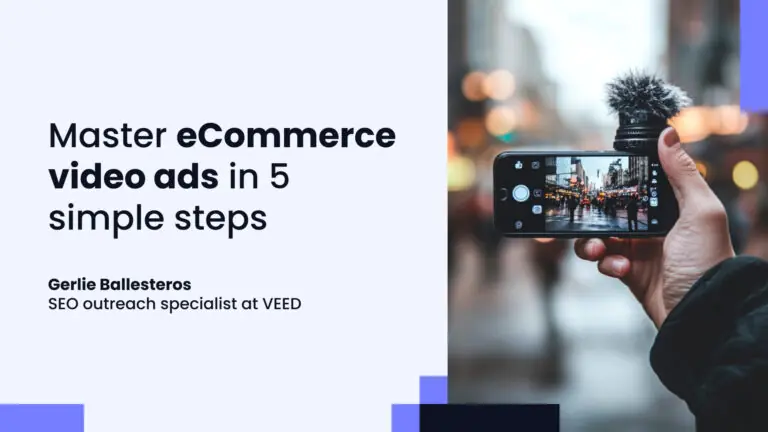
Video ads can make or break your eCommerce success. Learn five essential strategies to create high-converting campaigns that captivate and convert.

Crack the code to funding your eCommerce business with this step-by-step guide, and learn how to secure the capital you need to grow while staying on top of your strategy.
